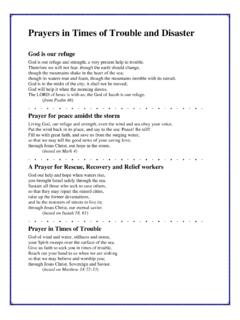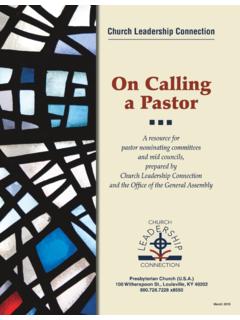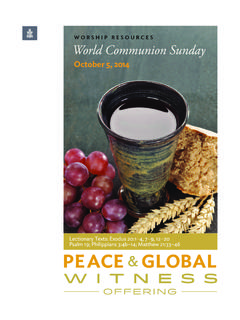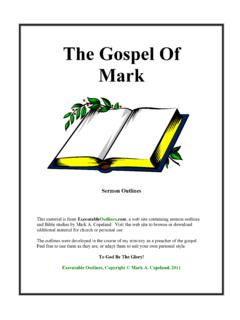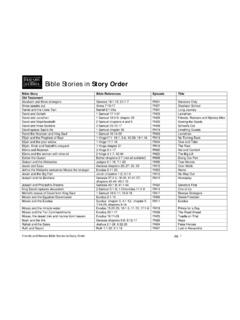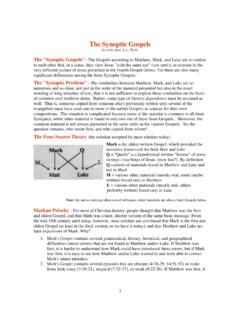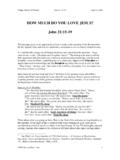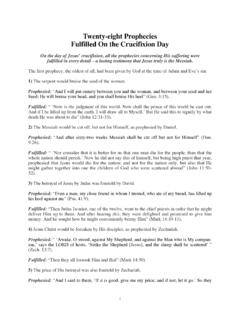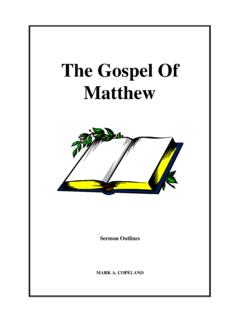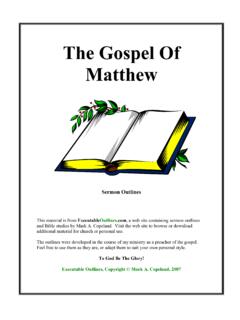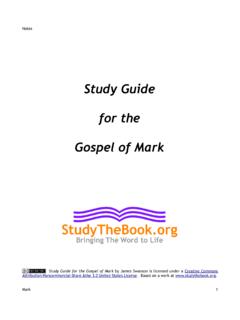Transcription of UNIQUE WORSHIP IDEAS FOR LENT - Presbyterian Church
1 UNIQUE WORSHIP IDEAS FOR lent USING LENTEN SYMBOLS The WORSHIP committee of a Church asked their pastor if she could preach on the symbols of lent during lent . Exactly what are the symbols of lent , though? The symbols of lent are those prominent in Lenten and crucifixion iconography. These are listed below with scripture references. Ashes Ashes are an ambiguous symbol in the Bible. Abraham says humans are but dust and ashes in Genesis 18:27, which Job repeats (Job 30:19). Contact with the ashes of a burnt sacrifice cause the need for ritual purification, as we see in Numbers 19:7. At the same time, though, the ashes of an unblemished red heifer, which is used for a sin offering (see Leviticus 4), are set aside for the purpose of purification in Numbers 19:9.
2 Hebrews 9:13-14 sees in this a figure of Christ: For if the blood of goats and bulls, with the sprinkling of the ashes of a heifer, sanctifies those who have been defiled so that their flesh is purified, how much more will the blood of Christ, who through the eternal Spirit offered himself without blemish to God, purify our conscience from dead works to WORSHIP the living God. Ashes are used as a symbol of repentance and grief throughout the Bible: see 2 Samuel 13:19, Esther 4:1ff, Job 42:6, Jeremiah 6:26, Jeremiah 25:34, Ezekiel 27:30, Jonah 3:6, Matthew 11:21, and luke 10:13 Daniel 9:3 provides the best description of the ritual use of ashes as a sign of repentance: And I set my face unto the Lord God, to seek by prayer and supplications, with fasting, and sackcloth, and ashes.
3 Ashes are symbols of divine judgment in Jeremiah 31:40, Lamentations 3:16, Ezekiel 28:18, Malachi 4:3, and 2 Peter 2:6. Ashes were also used as a disguise in 1 Kings 20:38ff. There is a sense that smearing ourselves with ashes and self-hatred is not what God wants, though, as we see in Isaiah 58:5ff. Indeed, God desires to give us beauty for ashes (Isaiah 61:3). Donkey The first time a donkey shows up in scripture is when Abraham prepares to sacrifice Isaac in Genesis 22. Interestingly enough, jesus is seen as being like Isaac in the early Church . Balaam s donkey is the one who speaks for God in Numbers 22. It was with the jawbone of a donkey that Samson overthrew the Philistines in Judges 15. Zechariah 9:9 is the prophetic text jesus follows as he rides into Jerusalem (Matt.)
4 21:1-11; Mark 11:1-11; luke 19:29-40; John 12:12-16): Rejoice greatly, O daughter of Zion; shout, O daughter of Jerusalem: behold, thy King cometh unto thee: he is just, and having PC(USA) Office of Theology and WORSHIP March 2011 salvation; lowly, and riding upon an ass, and upon a colt the foal of an ass. Palms Though Mark and Matthew mention cutting down branches to lay in the road before jesus triumphal entry into Jerusalem, only explicitly mentions people cutting down palm tree branches (John 12:13). Palm branches were specified material for the making of booths to celebrate gift of the Word dwelling (tabernacling) among the people of God in the wilderness (Leviticus 23:34-43). Palm trees characterized oases in the desert and may have been an allusion to the second place where the Israelites encamped after crossing the Red Sea (Exodus 15:27).
5 Jericho was known as the city of palms (2 Chronicle 28:15). Psalm 92:12 declares that the righteous shall flourish like the palm tree. Palm trees adorned Soloman s temple in I Kings 6-7, which Ezekiel recalls with his depiction of the establishment of the ideal Temple. By specifying palm branches, John may be making the theological point that the Lord is coming to dwell among us and establish the anticipated Kingdom through the Righteous One. Palm branches signified victory in the Roman world, and there are a plethora of palms in the early Christian art found in the Catacombs, martyrs resting chambers after death to signify that even in death, through Christ, the Christian life is one of victory over the forces of death, destruction, and evil Empire.
6 They represent a kind of righteous, victorious defiance against an unjust rule. Alabaster Flask This symbolizes the woman anointing jesus with the precious gift of nard she had in an alabaster container (Matt. 26:7, Mark 14:3, luke 7:37). The gift was equivalent to one year s wages and was considered to be his burial anointing. Anointing with aromatic oil, which is what nard was, was also done to set apart prophets, priests, and kings. 30 silver coins This is a symbol of the money Judas was paid to betray jesus (Matt. 26:15, Matt. 27:3, 3-10). It hearkens back to Zechariah 11:4-14 when God breaks covenant with Israel as God s sheep pay the Lord their Shepherd wages as would-be employers. This is an utter insult, for thirty pieces of silver is restitution for a gored slave according to the Law (Exodus 21:32).
7 See also Jeremiah 18:1-3, 32:6-15. Chalice Wine bottle These are all symbols of holy communion and the Last Supper. Loaf of Bread See Matt. 26:17-30, Mark 12: 25, luke 22:1-20 Grapes Wheat While being a symbol for communion, it also echoes what jesus says in John 12:24: Truly, truly, I say to you, unless a grain of wheat falls into the earth and dies, it remains alone; but if it dies, it bears much fruit. PC(USA) Office of Theology and WORSHIP March 2011 Wash Basin and Towel This is a symbol for the new commandment jesus gives his disciples during the Last Supper that we serve one another like jesus served us when he washed our feet like a slave (John13:1-15, 34-35). We celebrate this event on Maundy Thursday. Maundy is taken from the word mandatum, meaning law or command.
8 The new commandment comes at the same time that the new covenant is made with the Last Supper. Ironically, the wash basin and towel also signifies Pilate washing his hands of responsibility for jesus death, even as he allows it (Matthew 27:24). The mention of water and blood in this same verse echoes the water and blood that flowed from jesus side at his death (John 19:34). Rock and Praying Hands This is a symbol for jesus earnest prayer in the garden at Gethsemane. (Matthew 26:3646, Mark 14:32-42, luke 22:39-46) Crowing Rooster This is a double-edged symbol recalling Peter s betrayal of jesus , as the Lord had predicted, before the cock crows (Matt. 26, Mark 14, luke 22, John 18). Because a crowing rooster marks the dawn of a new day, it is also a symbol of the resurrection.
9 Cross An instrument of political torture and capital punishment used by the Romans to keep an occupied people terrified into complying with the law, the cross was a symbol of shame similar to an electric chair to us. Yet this is what God used to accomplish the divine purpose of atonement and communion with humanity through Christ s sacrifice of himself for us and our salvation. Cross Wound with a Serpent John links the cross with the bronze serpent in the wilderness raised for the people to look upon so that they would be saved from the snakes in Numbers 21:4-9 (John 3: 14-17). The serpent is an ancient symbol of evil and sin. When we are bit by the poison of sin, looking to jesus will keep us from dying. Dice Soldiers cast lots for jesus tunic in Matthew 27: 35, PC(USA) Office of Theology and WORSHIP March 2011 Mark 15:24, luke 23:34, John 19:24.
10 Although unclear as to exactly how this occurred (it could have been by drawing straws, for example), dice are the traditional symbol for gambling in a game of chance. What they saw as chance, however, might also be seen as an oblique allusion to the urim and thummim used by priests to determine God s will ( Exodus 28:30, Numbers 27:21). Spear This is what the soldiers used to ensure that jesus was dead by stabbing his side so that blood and water flowed from his heart (John 19:34). Blood and water signify the two sacraments of the Church flowing from out of the heart of God. Matthew, Mark, luke , and Paul link the blood of Christ with the cup of the New Covenant (Matthew 26:28 Mark 14:24 luke 22:20, and I Cor. 10:16), as blood was part of the sealing of a covenant in the ancient world.
